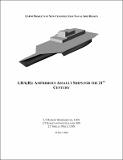LHA(R): Amphibious Assault Ships For The 21st Century
Author(s)
Bebermeyer, Robert; Galanis, Konstantinos; Price, Shelly
DownloadAmphibious Assault Ship 2002.pdf (2.638Mb)
Metadata
Show full item recordAbstract
Amphibious assault ships such as the current LHA and LHD classes are an essential element of the country's ability to exert influence anywhere in the world. The current amphibious assault ships represent the most capable amphibious ships in the world. The LHA 1 class ships are aging, however, with most reaching the end of their expected service lives between 2011 and 2015. It is not feasible to extend the service life of the LHA 1 class due to the rapid technological advances that have taken place during their lifetime. Most have already used their entire growth margin in areas such as combat systems and topside weights. The evolving combat systems and aircraft requirements will only exacerbate these matters. The best solution is to replace the LHA.
As the US faces a future with uncertain threats, it is necessary to field a flexible force. In order to make the amphibious forces flexible, selective offload capability must be considered. This allows Marines to access the equipment and vehicles they need for any given operation at any time. A second change that adds a great deal of flexibility is the addition of more ships. Currently, an Amphibious Ready Group (ARG) consists of three ships, an LHA or LHD, an LSD, and an LPD. Replacing the LHA with two ships has several advantages, ranging from increasing the selective offload capability of the ARG to optimally distributing assets among the ships. Most importantly, though, is the ability of the ARG to exert influence over a greater geographic area.
In this study, four different options were considered for the future ARG:
a. LPD 17, LSD 41, modified LHD 8 plus complement ship variants
b. LPD 17, LSD 41, two small LHD variants (2 ships with same hull)
c. LPD 17, LSD 41, two new design variants
d. LPD 17, LSD 41, single ship LHA(R) variants
After modeling a number of variants representing each option, an Overall Measure of Effectiveness (OMOE) and a total lifecycle cost was calculated. Analysis of these variants showed that the variants in Option (a) have a higher OMOE and a relatively lower cost than other options. This study now focuses on the complement ship to a modified LHD 8.
A comparison of hull forms, including catamarans, surface effect ships, hydrofoils, trimarans, monohulls, semi-planing monohulls, led to the selection of a trimaran, primarily for its ability to transport equipment at a high speed over a long range. In order to keep the size (and cost) of the ship down, the ship will not carry any landing craft. The nominal amphibious lift capacity of the trimaran complement ship is
Date issued
2002-05-30Series/Report no.
13.414 New Construction Design;
Keywords
amphibious ship, LPD, LSD, naval ship design, 13.414, trimaran